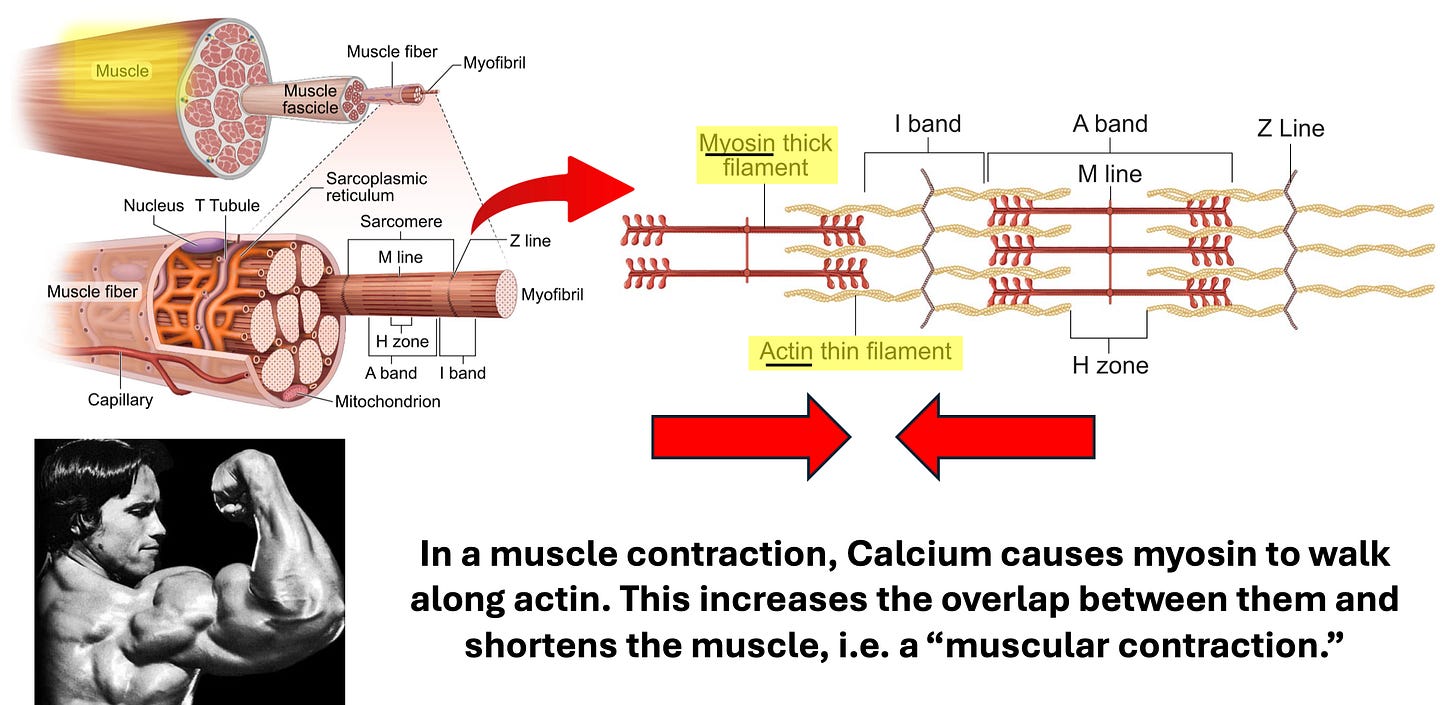New Data: Unexpected Benefits of Olives on Muscles
These new data show how a specific compound found in part of the olive plant can improve muscle performance in the short term, and potentially fight off age-related muscle loss.
These new data show how a specific compound found in part of the olive plant can improve muscle performance, and potentially fight off age-related muscle loss.
And – no – this is not snake oil, just olive oil… But not all olive oils.
I’m going to first break down the data, and then tell you how to use it for maximal muscle benefit.
Background: How Muscles Work
But first, I’m going to need to review with you a bit about how muscles work at the molecular level.
PLEASE bear with me here, because it will be fundamental to our discussion of the data – as well as your general understanding of how muscles work.
Inside muscles, there are long filamentous overlapping proteins called actin and myosin. The myosin has these little heads that branch off and grab on to actin.
When a nerve impulse hits a muscle, it causes a release of calcium inside the cell, and this allows myosin to walk along actin, pulling them together and increasing the overlap between actin and myosin, which translates to shortening of the muscle – a muscle flex. That, in effect, is a muscle contraction.
Now, here’s something important: this process is highly dependent on calcium.
It’s calcium that allows the actin and myosin to interact. And its calcium that also signals to the mitochondria to meet the energy demands of a muscular contraction.
Analogy: Calcium is to muscle as a responsible driver of is to a car. Calcium presses the gas pedal (signals muscle contraction) and fuels the tank to keep the engines (mitochondria) running.
Calcium Is Essential to Mitochondria In Muscles
Okay, now let’s introduce 1 of 3 key players: the mitochondrial calcium uniporter (MCU).
MCU is what transports calcium into mitochondria, and thus enables signaling to mitochondria to boost energy production. (We will explain how it does so momentarily.)
And the MCU is partnered with another protein, our 2nd player, MCU regulator 1 (or MCUR1), which is MCU’s essential sidekick: Like Batman and Robin, Rocket and Groot, SpongeBob and Patrick, Frodo and Sam, Ben & Jerry… you get the point.
MCU and MCUR1 work together to let calcium into mitochondria, and this is essential for energy production.
On To the The New Data!
The researchers first find that, in aging and age-related muscle loss (sarcopenia) in humans, MCUR1 levels drop.
This means less calcium is permitted into the mitochondria and less energy is effectively produced. And this is functionally important.
In fact, they find lower MCUR1 levels associate with worse muscle performance, including weaker grip strength and lower muscle mass.
So, pausing to review:
MCUR1 is part of an essential protein pair that lets calcium into muscles’ mitochondria to support energy generation.
MCUR1 levels decline with age, and are extra low in older persons with less muscle.
Lower levels of MCUR1 associate with less muscle mass and worse muscle performance.
Thus, if we could rescue MCUR1 – i.e. boost MCUR1 activity – we could potentially boost muscle function and performance.
They went on to show, critically, that there is a cause-effect relationship between MCUR1 and the processes in question by manipulating MCUR1 levels in human muscle cells, and dissected how exactly it works...
Basically, in mitochondria, there’s an energy generating cycle called the TCA cycle (a.k.a. Krebs cycle).
The gatekeeper of this cycle is a protein complex called Pyruvate Dehydrogenase (PDH).
PDH can be toggled “ON” / “OFF” with a molecular tag called a phosphate group, and the entry of calcium into mitochondria causes another protein (PDP) to remove the phosphate group tag from PDH, leading to its activation and – in effect – the doorway to the main energy generation cycle in mitochondria is opened up wide to increase energy production.
Summarizing again, because I know this is a lot:
Muscle contractions depend on calcium.
This calcium allows the key proteins in muscle (myosin and actin) to pull together, leading to a contraction.
To “feed” this contraction, the muscle cells also need to produce energy in mitochondria.
Calcium flowing into mitochondria, through MCU (assisted by MCUR1), enhances this process by opening up wide the molecular door to energy generation.
I hope that makes sense.
Now that we’ve covered how muscles work and why MCU and MCUR1 matter, let’s talk about a natural compound that could help solve the problem.
Boosting Muscles With Oleuropein
Enter our third player: Oleuropein, a natural compound found in olives, and in particular olive leaves.
The researchers wanted to identify natural compounds that activated MCUR1, hoping that doing so would boost muscle function. They screened 5,571 natural compounds, and Oleuropein stood out.
Oleuropein binds a subunit of MCU (called MICU1, shown below) even at very low concentrations, increases calcium flux into mitochondria, opens up the door to the energy producing TCA cycle in mitochondria, and thus stands to enhance muscle function.
Indeed, they find that Oleuropein supplementation in the form of olive leaf extract given to young mice increased muscle performance by reducing fatigue and increasing endurance on a treadmill running test. So, Oleuropein has fast action. But what about its chronic use?
In aged mice with reduced muscle mass, Oleuropein also increased muscle mass, suggesting applications for sarcopenia, which is stunning and hopeful!
Oleuropein for Me and You?
And importantly, Oleuropein-rich compounds, like olive leaf extract, are bioavailable, considered safe for human use, and available for purchase. I have no affiliations or specific brand recommendations for olive leaf extracts, but I do love good extra virgin olive oil! So, I did some internet sleuthing and found that there are a few specific olive oils enriched in Oleuropein. (No affiliation).
But more to the point, consider that the Mediterranean region of the world – who tend to eat a diet relatively rich in Oleuropein – also tend to have high rates of healthy aging. And, while I wouldn’t attribute this to solely Oleuropein, that observation coupled with the fascinating research presented in this paper, definitely has me excited about the potential benefits of maintaining high Oleuropein as I age.
Plus, I LOVE extra virgin olive oil anyway.
Takeaways
First, science continues to uncover incredible links between diet, specific compounds, and how our bodies perform and age.
Second, Oleuropein is a shining example of how a natural compound – one already part of the human diet for millennia – could hold the key to improving muscle performance and combating age-related muscle loss.
If you’re excited by the possibility, it might be worth exploring Oleuropein-rich olive oils or olive leaf extracts.
Finally, let this be a reminder that something as simple as enjoying olives and olive oil might not just be tasty but also supportive of your long-term health.
So drizzle that extra virgin olive oil, savor those olives, and keep moving those muscles.
So, whether you’re drizzling olive oil on your salad or adding olive leaf extract to your routine, you’re giving your muscles a gift. If this research inspired you as much as it did me, subscribe and share this letter with someone who loves science—or olives—as much as you do! #StayCurious and Let’s Make Metabolic Health Mainstream!
P.S. Promotion: Happy New Year & 30 Day Challange
One thing 2024 revealed to us is that there’s a strong public will to see sweeping change in the social structure and food environment that has caused the metabolic health epidemic.
But people aren’t waiting for policy change, they’re voting with their attention and dollars – opting to spend their personal time and efforts learning, cleaning up their diets, and transforming their N = 1 lives for the better.
2025 is going to see the Metabolic Health Revolution Rise like Phoenix.
To that end, I challenge you to start off 2025 with a metabolic health gift to yourself, a 30-day challenge!
Choose your rules or select those I’ve provided. Then track your progress, not on the scale on under the bench press alone, but in your blood.
To support this effort, and as a generous support for a limited time, SiPhox is offering you 50% off two at-home mail-in metabolic health testing kits plus $100 off future testing kits. This discount was selected, not to make a profit, but to help them just cut even while ringing in the new year supporting metabolic health awareness!
Get you 30 day challenge lab kits HERE. The link also describes what I’ll be doing, but this is truly a “choose your own adventure!” You choose and the proof is in the pudding (blood labs). Labs you’ll get:
ApoA, ApoB, HDL-C, LDL-C, Triglycerides
Cortisol
Fasting Insulin
HbA1c
Testosterone
Estradiol, FSH
25-Vitamin D
Ferritin
Homocysteine
hsCRP
TSH
AND HAPPY NEW YEAR!











Great about the olives, even better the 30 day challenge. Kits ordered!
I'm 72 and definitely noticed my strength declining over the last 10 years. Looks like I'll be doing an N=1 with Hypereleon. Thanks.